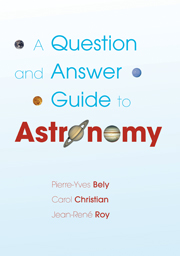Telescopes
Published online by Cambridge University Press: 24 May 2010
Summary
Astronomy is essentially a passive science. Aside from exploring the Moon and our nearest planetary neighbors, we cannot make experiments directly, we can only observe and try to understand what we see. And the master tool for making observations is the telescope.
How do refracting and reflecting telescopes differ?
Generally speaking, a telescope† is an instrument that enhances the observation of celestial objects by increasing their apparent size and luminosity. This applies to the entire electromagnetic spectrum, from radio waves to gamma rays, including of course the “optical domain,” which covers visible light and radiation in the infrared and ultraviolet. Optical telescopes can be very diverse, but basically they work just like a photographic camera: they focus the light of a celestial object to form a real image‡ on film or on an electronic detector. In the visual version, an “eyepiece,” which is basically a magnifying glass, is used to observe the image directly.
The terms “refracting” and “reflecting” simply refer to the composition of a telescope's optics. If lenses are used, the instrument is a refracting telescope; if mirrors are used, it is a reflecting telescope.
Which system is better? Well, in general, the larger the telescope – that is, the larger its main mirror or lens – the more light it can collect and the fainter the object it can observe (Q. 205). Reflecting telescopes can be built very large indeed, whereas refracting telescopes have serious size limitations.
- Type
- Chapter
- Information
- A Question and Answer Guide to Astronomy , pp. 209 - 249Publisher: Cambridge University PressPrint publication year: 2010



